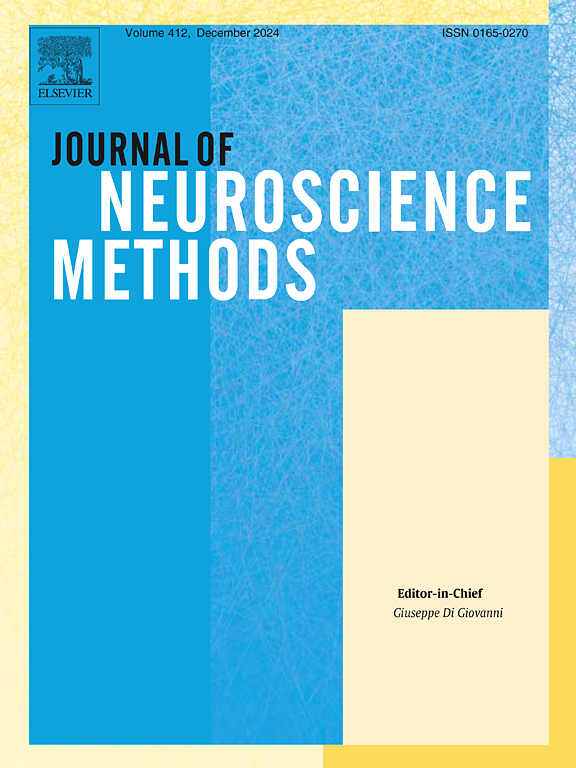Convolutional Neural Networks for the segmentation of hippocampal structures in postmortem MRI scans
IF 2.7
4区 医学
Q2 BIOCHEMICAL RESEARCH METHODS
引用次数: 0
Abstract
Background:
The hippocampus plays a crucial role in memory and is one of the first structures affected by Alzheimer’s disease. Postmortem MRI offers a way to quantify the alterations by measuring the atrophy of the inner structures of the hippocampus. Unfortunately, the manual segmentation of hippocampal subregions required to carry out these measures is very time-consuming.
New Method:
In this study, we explore the use of fully automated methods relying on state-of-the-art Deep Learning approaches to produce these annotations. More specifically, we propose a new segmentation framework made of a set of encoder–decoder blocks embedding self-attention mechanisms and atrous spatial pyramidal pooling to produce better maps of the hippocampus and identify four hippocampal regions: the dentate gyrus, the hippocampal head, the hippocampal body, and the hippocampal tail.
Results:
Trained using slices extracted from 15 postmortem T1-weighted, T2-weighted, and susceptibility-weighted MRI scans, our new approach produces hippocampus parcellations that are better aligned with the manually delineated parcellations provided by neuroradiologists.
Comparison with Existing Methods:
Four standard deep learning segmentation architectures: UNet, Double UNet, Attention UNet, and Multi-resolution UNet have been utilized for the qualitative and quantitative comparison of the proposed hippocampal region segmentation model.
Conclusions:
Postmortem MRI serves as a highly valuable neuroimaging technique for examining the effects of neurodegenerative diseases on the intricate structures within the hippocampus. This study opens the way to large sample-size postmortem studies of the hippocampal substructures.
卷积神经网络对死后MRI扫描海马结构的分割。
背景:海马体在记忆中起着至关重要的作用,是最早受阿尔茨海默病影响的结构之一。死后MRI通过测量海马内部结构的萎缩,提供了一种量化改变的方法。不幸的是,手工分割海马亚区需要执行这些措施是非常耗时的。新方法:在本研究中,我们探索了依靠最先进的深度学习方法来生成这些注释的全自动方法的使用。更具体地说,我们提出了一种新的分割框架,该框架由一组嵌入自我注意机制的编码器-解码器块和复杂的空间锥体池组成,以产生更好的海马体地图,并识别出四个海马体区域:齿状回、海马头、海马体和海马尾。结果:使用15个尸检t1加权、t2加权和敏感性加权MRI扫描提取的切片进行训练,我们的新方法产生的海马包裹体与神经放射学家提供的人工描绘的包裹体更好地一致。与现有方法的比较:采用四种标准的深度学习分割架构:UNet、Double UNet、Attention UNet和Multi-resolution UNet,对提出的海马区域分割模型进行定性和定量比较。结论:死后MRI是一种非常有价值的神经成像技术,可用于检查神经退行性疾病对海马内复杂结构的影响。这项研究为海马亚结构的大样本死后研究开辟了道路。
本文章由计算机程序翻译,如有差异,请以英文原文为准。
求助全文
约1分钟内获得全文
求助全文
来源期刊

Journal of Neuroscience Methods
医学-神经科学
CiteScore
7.10
自引率
3.30%
发文量
226
审稿时长
52 days
期刊介绍:
The Journal of Neuroscience Methods publishes papers that describe new methods that are specifically for neuroscience research conducted in invertebrates, vertebrates or in man. Major methodological improvements or important refinements of established neuroscience methods are also considered for publication. The Journal''s Scope includes all aspects of contemporary neuroscience research, including anatomical, behavioural, biochemical, cellular, computational, molecular, invasive and non-invasive imaging, optogenetic, and physiological research investigations.
 求助内容:
求助内容: 应助结果提醒方式:
应助结果提醒方式:


